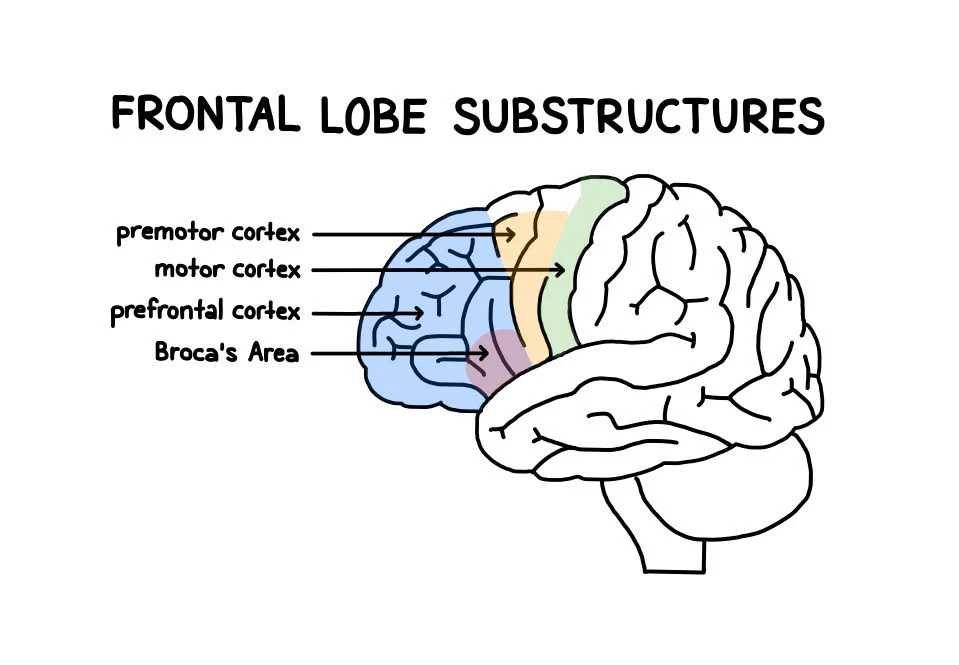Originally answered on Quora: Could a human survive without the frontal lobe?
Theoretically, yes, humans can live without a frontal lobe. The frontal lobe encompasses the prefrontal cortex (PFC) and the motor cortex. Removal of the motor cortex in both hemispheres of the brain would produce complete paralysis with intact sensations – similar to the unfortunate outcome of ALS sufferers (e.g., Stephen Hawking). Certainly, losing all motor control could be considered as “barely surviving,” so what would survival look like if we removed just the PFC?
Tract-tracing of white-matter connections have revealed that the PFC is interconnected with areas throughout the brain, including sensory and motor areas [1,2] and posterior association cortices [3-6]. Interestingly, PFC damage in humans can result in no obvious impairments in cognitive functioning and general intelligence [7]. This might seem surprising, given the high degree of involvement that’s inferred by its pattern of widespread connectivity.
The first studies in monkey PFC did not observe substantial changes in behavior from ablating portions of the region, as well as from entire resections of left or right PFC. It wasn’t until scientists had attempted to remove both left and right PFC did they begin to unmask its critical functions. These monkeys without a PFC showed predominantly disinhibited, stimulus-bound behaviors that lacked goal-directedness and contextual-influence [8]. These monkeys would automatically perform simple actions elicited from previously well-learned stimulus-response associations, such as reaching for a door handle. However, they wouldn’t and couldn’t open doors, which is a complex, goal-oriented action that requires turning the handle and moving the door to open.

Humans with significant prefrontal impairments from strokes or traumatic-injuries can display similar disinhibited symptoms termed inappropriate utilization behaviors. Certain objects and settings can compel these individuals to perform the associated action without regard to the appropriateness of the context [9,10]. Many fascinating anecdotal stories of these patients with damage to the PFC are available. For example, one story recounts of a patient who had worked in an executive position for numerous years prior to his frontal stroke. Now he would enter his doctor’s office and unconsciously take a seat behind the desk in the doctor’s chair. Another patient, upon seeing a stapler, was compelled to staple together any loose paper that was sitting on the desk. Yet another patient saw a toothbrush and automatically picked it up to brush her teeth. When the doctor asked her why she was brushing her teeth, she simply said she didn’t know.
In addition, PFC damage can also disinhibit emotions, leading to emotional lability and volatile behaviors. This is seen in orbital frontal lesions, such as the classic story of Phineas Gage. Although Phineas had survived having an iron tamping rod shoot through his face and brain, anecdotal stories of him in the following years describe him as impetuous and irritable, as well as socially inappropriate (though in much later years, he eventually relearned much of his lost interpersonal skills).
Taken together, the critical functions of the PFC appear to be related to the processes that subserve performance of complex behaviors appropriate for the given context. If a human were to suddenly lose their entire PFC, this person would survive, but would also be stimulus-bound. This person would be unable to plan and execute complex, multi-step actions, and incapable of inhibiting inappropriate prepotent behaviors. Plus, this person would no longer be able to verbally express themselves with language and would have specific memory processing deficits (both of which I wasn’t able to fully discuss here, but use the same underlying processes for complex behaviors). On the plus side, word comprehension should be mostly intact (but not grammar), since understanding word meanings relies more on posterior brain regions.
- Bates, J.F., and Goldman-Rakic, P.S. (1993). Prefrontal connections of medial motor areas in the rhesus monkey. Journal of Comparative Neurology 336, 211-228.
- Lu, M.-T., Preston, J.B., and Strick, P.L. (1994). Interconnections between the prefrontal cortex and the premotor areas in the frontal lobe. Journal of Comparative Neurology 341, 375-392.
- Barbas, H., Henion, T.H., and Dermon, C.R. (1991). Diverse thalamic projections to the prefrontal cortex in the rhesus monkey. Journal of Comparative Neurology 313, 65-94.
- Pandya, D.N., and Yeterian, E.H. (1990). Prefrontal cortex in relation to other cortical areas in rhesus monkey: architecture and connections. Prog Brain Res 85, 63-94.
- Petrides, M. (1995). Functional organization of the human frontal cortex for mnemonic processing. Evidence from neuroimaging studies. Ann N Y Acad Sci 769, 85-96.
- Seltzer, B., and Pandya, D.N. (1989). Frontal lobe connections of the superior temporal sulcus in the rhesus monkey. J Comp Neurol 281, 97-113.
- Mesulam, M. (1986). Frontal cortex and behavior. Annals of neurology 19, 320-325.
- Bianchi, L., and Macdonald, J.H. (1922). The mechanism of the brain: and the function of the frontal lobes (E. & S. Livingstone).
- Lhermitte, F. (1983). Utilization behaviourand its relation to lesions of the frontal lobes. Brain 106, 237-255.
- Shallice, T., Burgess, P.W., Schon, F., and Baxter, D.M. (1989). The origins of utilization behaviour. Brain 112, 1587-1598.
Source of cover image: SimplyPsychology
